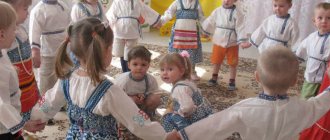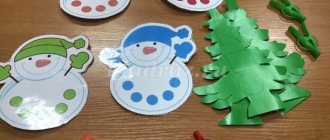Didactic games for speech therapy classes with preschoolers
Speech therapy educational games for preschoolers
Educational games Author: Tatyana Vasilievna Chervyakova, speech therapist, MDOU kindergarten “Rodnichok” Description: The presented didactic games will be useful for speech therapists and kindergarten teachers. The material is intended for conducting individual and subgroup speech therapy sessions with preschoolers.
Purpose of the game: to activate vocabulary on the topic “Vegetables” and “Fruits”; Teach children to divide words into syllables. Material: drawings: planar images of baskets with syllabic patterns, images of objects - vegetables and fruits. Progress of the game: Speech therapist. Guys, today we are going to visit our grandparents in the village to see what vegetables have grown in the beds. – And then our grandparents meet us.

Speech therapist. Grandma invites you to guess what vegetables they collected. – round, red, juicy, healthy, soft... (tomato) – oval, green, crunchy, rough, hard... (cucumber) – oblong, orange, hard, tasty, vitamin... (carrot) – round, bitter, hard, healthy ... (onion) - round, green, juicy, crispy... (cabbage)

Speech therapist. Guys, you guessed all the vegetables. Now let's put them in baskets. – Notice what beautiful baskets grandma prepared. Each basket has a syllabic pattern. Let's name the vegetables one by one, determine the number of syllables in each word and put the vegetable in the correct basket.

A similar game can be played on the theme “Fruits”. As material we use images of objects - fruits.

Didactic game “Syllable Houses” Purpose of the game: to teach children to break words into syllables. Material. Airplane images of houses with window pockets. Every house has a syllabic pattern. Images of objects depicting fairy tale characters: Wolf, Carlson, Dunno, Pinocchio, Malvina, Puss in Boots and others. Progress of the game. Speech therapist. The heroes of fairy tales came to visit us. Nominal. Child. Wolf, Carlson, Malvina, Pinocchio, Aibolit.
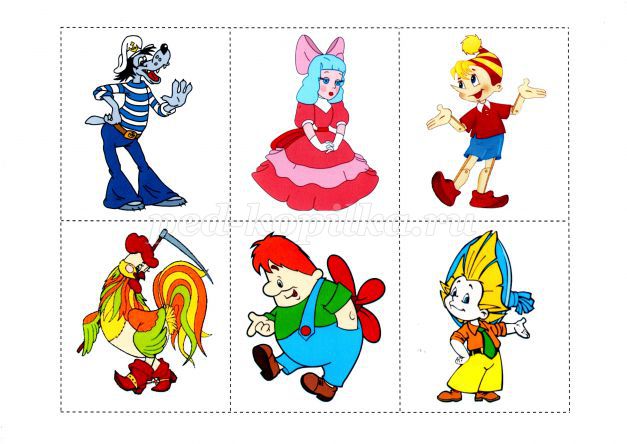
Speech therapist. Guests should be “settled” in houses. Determine the number of syllables in each word and “place” the hero in the desired house.
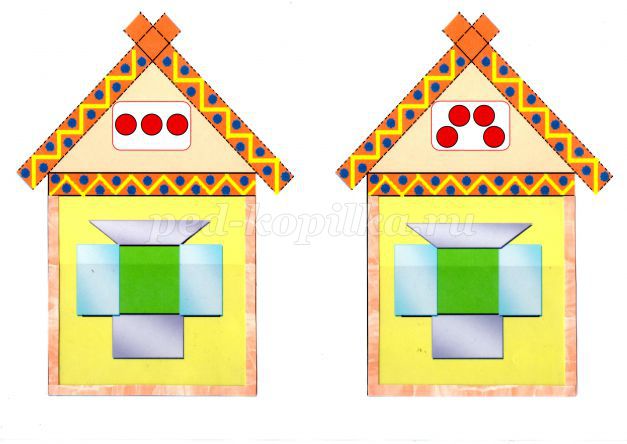
Child (speak and emphasize the syllables) - “Karl the Son” - two syllables (puts the photo in the pocket of house No. 2) - “Wolf” - 1 syllable (puts the picture in the pocket of house No. 1).
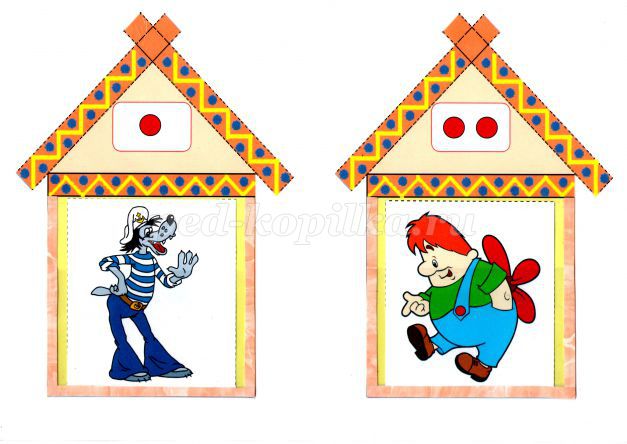
- “Mal-vi-na” - this word has three syllables (puts the picture in the pocket of house No. 3) - “Bu-ra-ti-no” - the word has four syllables (puts the picture in the pocket of house No. 4)
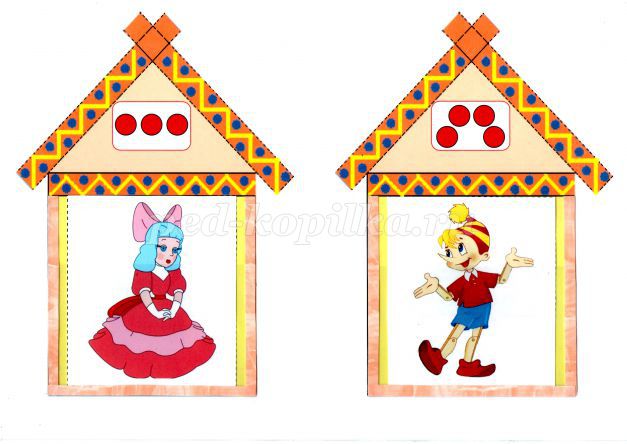
Speech therapist. Very good! The manual can be used when studying other lexical topics.
We recommend watching:
Speech therapy games for preschoolers Games for the prevention of optic dysgraphia and dyslexia in preschoolers Speech therapy games for kindergarten using animals Do-it-yourself speech therapy board games for kindergarten
Similar articles:
Speech therapy games for preschoolers and primary schoolchildren
DIY speech therapy games for preschoolers
DIY speech therapy games
Speech therapy game for older preschool children
Speech therapy game for children 5-8 years old “Who is faster”
Outdoor games in speech therapy classes
Dear colleagues, I want to share with you my experience in using active and sedentary games in speech therapy classes .
According to the new requirements of FGT, children in classes should move as much as possible, so for this I have developed and reworked folk outdoor games that can be used in classes to develop speech on a certain lexical topic. I hope that the games I have selected will help you conduct classes by activating the motor activity of children.
Organization of motor activity of children during a speech therapy session using outdoor games
Everyone knows this saying: “Movement is life.” A mobile person is an active person, manages everything, gets less tired.
Our education system sets itself the goal of raising a comprehensively developed person, but a child already at preschool age experiences the harmful effects of physical inactivity. According to psychologists, a small child is a doer. His activity is expressed primarily in movements. The more varied the movements, the more information enters the brain, the more intense the intellectual development. Speech development is also directly related to speech development. Therefore, new federal state requirements include the organization of physical activity in classes.
It is most effective to include outdoor games in classes.
An outdoor game, like any didactic game, is aimed at achieving certain educational and training goals. The use of outdoor games in the classroom helps to increase children's performance, relieve stress, and facilitate switching from one activity to another.
Outdoor games in a speech development class can be used as an element of the lesson, as a physical education moment, or as a reinforcement of the material covered.
In a playful form, thinking proceeds faster, and new educational material is absorbed more firmly and remembered more easily.
Speech games include outdoor games with speech content, Russian folk games, round dance games, didactic, verbal, board and printed games, dramatization games, finger nursery games, etc.
Any outdoor game can be adapted to the lexical topic of the week and used in joint activities with the child.
I offer you outdoor games for speech development: folk games, ball games, original games.
Folk outdoor games for speech development
Folk outdoor games stimulate active thought, help broaden one’s horizons and clarify ideas about the world around us. Folk games have a lot of humor, jokes, and competitive fervor; the movements are precise and figurative. Each folk game begins with a counting rhyme, a melodious and funny sing-along, and entertaining dialogues. They are firmly and quickly remembered by children and pronounced in everyday life, this develops memory and speech. Folklore is passed down orally from generation to generation and never grows old.
"Fanta"
Goal: activation of the vocabulary of nouns, adjectives on a given topic, development of auditory attention and memory.
The presenter says:
— They sent you 100 rubles. Buy what you want, don’t take black, don’t take white, don’t say “yes” or “no!”
After these words the following dialogue is given:
— What is sold in the bakery? (children in a circle, they say what can be sold in a bakery) - Bread, loaf, rolls. — What kind of bread is sold in the bakery? - Soft, fresh, fragrant, crispy, toasted.
In order to see which of the children is answering, you can use a ball or a stick.
A similar game can be played on the topic “Food”, “Clothing”, “Fruits and Vegetables”
"Paints"
Goal: activation of the vocabulary of nouns, adjectives on a given topic, coordination of nouns with adjectives in gender, number, development of higher mental functions.
Children come up with the color of a certain paint (you can come up with a certain material, taste, depending on the topic, the goal that the teacher has set for himself). A buyer is selected from among the children, he comes and says:
- Knock Knock! - Who's there? - Buyer. - Why did you come? - For paint. - For which one? - For the blue one.
If the buyer guesses the color of the paint, then the paint goes to him, but she can redeem herself if she names (depending on the topic) 5 names of blue clothes or 5 dishes made from potatoes.
"Mail"
Goal: activation of the vocabulary of verbs on the topic, development of higher mental functions.
The game begins with a roll call between the driver and the players:
- Ding-ding-ding. - Who's there ? - Mail! - Where? - From the city. What are they doing in the city? (from school, garden, vegetable garden)
Children in a circle must say that in the city they dance, sing, jump... That child who takes a long time to find the word to become a postman.
"Needle, thread, knot"
Goal: to activate the vocabulary of nouns on the topic, the development of higher mental functions.
Children playing stand in a circle, holding hands. Using a counting table, children choose a needle, thread and knot.
A thread, a needle, a knot stand in a circle, the rest of the children take each other’s hands and pass the thread, needle, knot through the circle, naming different types of clothes (winter, summer, clothes for a boy or a girl), the child who could not name the right one clothes become in a circle.
"Get your hat"
Goal: to develop children’s vocabulary, differentiate objects according to certain characteristics, develop higher mental functions, general motor skills.
Children are divided into two teams. There are objects of different categories on the table, for example, hats and clothes. Children must collect their own items in each team. Children playing move towards the table in pairs, either jumping, walking, or walking on their toes.
"Silence"
Goal: development of auditory perception, to form diminutive forms of nouns.
Children stand in a circle and say the chant:
- Firstborns, little ones, little pigeons flew through the fresh dew, along someone else's strip, there are cups, nuts, honey, sugar - Silence!
When the last word is said, everyone must be silent. The leader spins in a circle with his eyes closed, in front of whom he stops, this child must call him. The host must guess who called him and call him affectionately.
"Shuttle"
Goal: develops children's vocabulary on a given topic.
Children are divided into two walls, they move towards each other, singing the words:
— The shuttle is running, the earth is trembling, he is sewing. amuses us.
The rest of the children try to run between the shuttle, naming words on the topic that they agreed on in advance.
"Seine"
Goal: to activate the vocabulary of adjectives, to be able to describe an object according to certain characteristics.
Children choose a fish, this player is placed in a circle. Children stand in a circle, the teacher shows a picture of a vegetable, a toy, but so that the fish does not see the picture. Whenever the fish swims up to him, the child begins to describe the object without naming it. If the fish guesses the object, it swims into the circle.
"Paradise-paradise"
Goal: activation of the vocabulary, development of verbal and auditory memory.
Two gate children are chosen for the game; the rest are mothers and children playing.
The gate children raise their clasped hands up and say:
- Heaven, heaven, I let you pass, And I leave the last ones. The mother herself will pass and see the children through.
Children stand up like a train and walk through the gates, the last child stops at the gates and says a word on the topic, for example: bus, and the child stands up next to them. Gradually all the children become masters and remember the words that the little engine called.
"Blind Man's Bluff Porters"
Goal: sensory development, perception development.
Toys on a specific topic are laid out on the table. Children are blindfolded; with their eyes closed, the child must describe the object by touch and guess it.
"Gakkaris"
Goal: development of vocabulary, development of general motor skills, forming the plural of nouns.
Children squat in circles cut out and arranged in a circle. The driving player jumps on one leg in a circle, the player near whom the driver stopped must name many instead of one object. If the person sitting makes a mistake, he becomes the leader.
"We sell pots"
Goal: to activate the vocabulary on the topic, to coordinate nouns with numerals.
Children are divided into pairs: the seller and the potty. Children sit in a circle. Children have potty objects with subject pictures on a given topic. The presenter approaches one of their hosts and begins a conversation:
- Hey, buddy, sell the pot! - Buy it. - How many rubles should I give you? - Give me three. (Give me five...)
The presenter must correctly match the name of the picture with the number guessed by the owner: three buses, five carriages.
"Guess and catch up"
Goal: development of phonemic hearing.
The players sit on the bench. The driver sits in front. He is blindfolded. One of the players approaches the driver and calls him by name. The driver must guess who it is. If he guessed right, he quickly takes off the bandage and catches up with the runner. If the driver says the player's name incorrectly, then another player comes up.
"Duck"
Goal: to activate the vocabulary on the topic, to be able to form sentences on the topic.
Two children sit opposite each other on chairs. The legs are extended forward, toes up. A duck is chosen, the rest of the children are ducklings.
The duck calls her ducklings with a tongue twister:
- Faster, faster, ducklings, Faster, faster, wild feathers.
The ducklings stand one after another and walk across the bridge, making sentences about the time of year or on a certain topic.
Ball games for speech development
Ball games are very useful for the development of children with speech disorders. The ball helps to diversify correctional work, activates fine and gross motor skills, spatial orientation, attention, helps to establish contact with children, and normalizes the behavior of hyperactive children.
"Big Ball"
Goal: to activate the vocabulary of verbs, the development of general motor skills and higher mental functions.
Children stand in a circle with a ball in their hands. The presenter calls the word and throws the ball to one of the children. Children throw the ball in a circle, naming the actions that an object called the leader can perform (snowing, falling, melting, crunching, sparkling).
“Throw the ball and name the animals”
Goal: to activate the vocabulary on this topic.
You can choose any other generalizing concept.
The presenter thinks of the category he has chosen; the children must throw the ball and name the words that correspond to the general concept.
"Ball"
Goal: to activate the vocabulary on the topic, select antonyms for words.
The players are divided into two teams. Some call the word -sign: high, and the other team calls the opposite sign: low.
"Rolling the Ball"
Goal: to activate the dictionary on the topic.
The speech therapist sets a task: for example, name as many beautiful words as possible about mom (What kind of mom?). Children take turns rolling the ball into a hoop, naming adjectives.
"Ball in a Circle"
Goal: to activate the dictionary on the topic.
Children sit on the table, and the driver stands behind the circle and holds the ball. The driver names a general concept and throws the ball to one of the sitting players. Children must name words that are suitable for this general concept as quickly as possible. The player who holds the ball becomes the leader.
"I know five names"
Goal: activation of the dictionary on a given topic.
Progress of the game: Children stand in a circle with the speech therapist holding the ball, he begins the task “I know five names of fruits,” after which the ball is passed around the circle, each child must name five fruits.
Author's outdoor games for speech development
"Jump over the ditch"
Goal: development of verbal vocabulary, development of general motor skills, learning to select antonyms.
Two jump ropes are laid out on the floor parallel to each other. Children are divided into two teams. The first child jumps over the ditch, naming the verb, and the next child names the opposite verb: stands - walks, shaves - puts down.
"Magic Circle"
Goal: learn to come up with sentences, activate verbal vocabulary, expand your vocabulary on a given topic.
Material: multi-colored circle, consisting of sectors of different colors.
The guys stand along the edge of a multi-colored circle. The speech therapist suggests imagining that the circle is a flowerbed. The child thinks of a flower that has the color of any sector, names the plant and its flowers rolls the ball into the corresponding sector.
Speech therapist: A red rose grew in the flowerbed - the ball rolls into the red sector.
To complicate matters, verb vocabulary is used: not only is the name and color pronounced, but it is also said what is happening to the flower: it has grown, formed a bud, smells good, blooms.
"Carousel"
Goal: to strengthen children’s ability to write a short descriptive story using simple and complex sentences in speech
How to play: Children stand in two circles. There are two or three people in the outer circle. The rest are in the internal. One circle moves clockwise, the other counterclockwise.
The outer circle recites the rhyme:
Carousel, spin around, and then stop. Whoever guesses the word gets into our friendly circle.
Then a child from the outer circle asks a short riddle - a description of the object. Children from the outer circle guess the riddle; if they guess it, they stand in the inner circle.
“Show, guess and repeat”
Goal: to activate vocabulary on a given topic, develop general motor skills, and be able to coordinate movements and speech.
Progress of the game: Children stand in a circle, a leader is chosen, he thinks of a profession (or some fruit, dishes), but does not name it, but only shows it with gestures. Children must guess the hidden object and show that the child who guessed first becomes the leader.
"Shoe salesman"
Goal: to activate the vocabulary on the topic, to coordinate nouns with adjectives and numerals, to be able to describe an object according to its main features.
Progress of the game: A shoe seller is selected; he has different shoes, which are displayed in front of the children. The guys remember what shoes are sold in the store, then the shoes are put away under the counter. The seller asks how many sandals, felt boots, and boots he had in the store. Then each child describes the shoes they want to buy. According to the description, the seller must sell the shoes correctly.
"Magic Traces"
Goal: to activate vocabulary on the topic, learn to form possessive adjectives.
Progress of the game: In front of the children are carved footprints of various animals. Children are asked to follow the tracks, naming whose tracks they are - wolf's, hare's. If the children correctly name the tracks, then this animal is waiting for them at the end of the path.
"Who's clever"
Goal: to activate the vocabulary on the topic, teach to generalize, classify.
Progress of the game: Children are divided into teams and determine who will collect which category. The speech therapist has objects of different categories on his table. At the teacher’s command, one participant from the team comes to the table and collects only those items that are necessary for his category.
“I fly, I go, I swim”
Goal: develop gross motor skills, activate vocabulary on the topic.
How to play: Children stand in a circle. The speech therapist names the transport, and the children must show how the transport moves.
"We'll go visit"
Goal: to activate vocabulary on the topic.
Progress of the game: Children line up in a long chain and follow the teacher, saying the words: “We will go on a visit and take our friends with us.” We'll find out who lives in the house. Knock-knock, knock-knock.” Who lives in the house? A man lives in the house who works on an excavator. Afterwards we remember who lived in each house.
"Snail"
Goal: to activate vocabulary on the topic; agree nouns with numerals.
Progress of the game: A snail is drawn in front of the children - hopscotch from one to ten. The speech therapist suggests counting an object to ten. The child jumps onto the first square and counts: one orange, two oranges, etc.
"Color Range"
Goal: agree nouns with adjectives.
Progress of the game: Multi-colored figures are located in front of the children. The speech therapist names the fruit, and the children must say what color it is and run up to the figure of the desired color.
Mitrofanova Svetlana Anatolyevna, teacher-speech therapist of the highest category, S/p d/s "Korablik" GBOU secondary school No. 19, Novokuibyshevsk
Literature: 1. Innovations in speech therapy practice.// Compiled by O.E. Gromova Linka-press. 2008 2. Children's folk outdoor games. // Compiled by A. V. Keneman, T. I. Osokina M: “Enlightenment” “Vlados” 1995 3. L. V. Vinogradova “Game library. Playground”, “Grow up, first-grader” No. 6/7 4. E. Velikina “Melomania”, “mamas & papas”, May 2011.
- Visual gymnastics in speech therapy classes
- Development of fine motor skills of the hands as one of the activities in speech therapy classes
- Using health-saving technologies in speech therapy classes
- Speech therapy games, word games
- Verbal didactic games for the development of the vocabulary of children with special needs [Experience in implementing the project]
( 8 liked, average score: 4.50 out of 5)
Loading...
The role and significance of speech therapy games
The process of further development of the child depends on how well the speech is formed. That is why it is so important to promptly prevent various defects and monitor the purity of the sounds produced by the baby. Violations are noted not only in the speech of a preschooler, but also in perception and production itself. When determining the degree of the defect, all symptoms associated with mental, physical and speech development are identified.
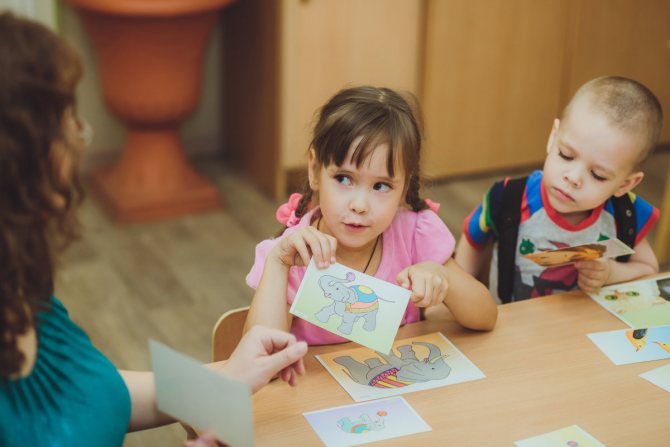
Language educational games
Note! Play is the main activity of a child; with its help, he masters various forms of thinking and develops his horizons. Speech therapy games play an important role in creating a favorable environment for a child to overcome speech disorders of varying severity.
Speech therapy educational games for preschoolers have great potential: with their help, the student works on correct pronunciation of words, learns their native language and learns the rules of grammar in a simple form. Difficulties overcome in this way in a playful way are less obvious and tangible for the child.
The main significance of speech therapy games is to increase the vocabulary and horizons of children, expand the boundaries of the child’s consciousness and introduce him to the world around him.
How games help a speech therapist
Every year the percentage of preschool children with speech pathologies of varying complexity and etiology increases. To correct standard speech disorders, you need to practice at least 2-3 times a week for 30 minutes. However, it is difficult to captivate children with a monotonous task; they quickly get tired and refuse to complete the exercises suggested by the teacher. To increase motivation for learning, speech therapists use game techniques in their classes, thanks to which the correction process ceases to be boring for the child.
What else to read: Didactic games for the development of phonemic awareness
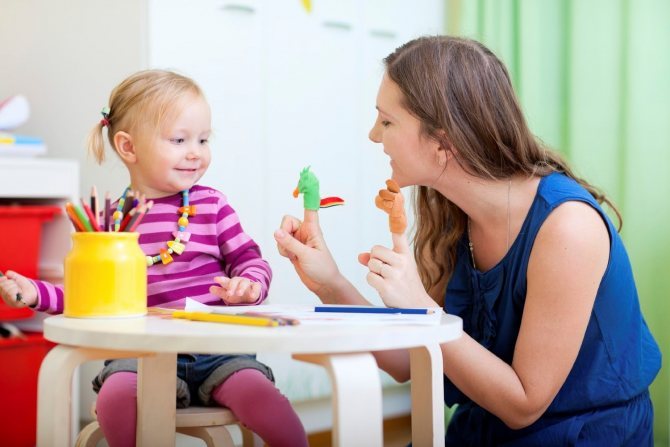
Speech therapist and child
Speech therapy games with a flashlight for children
Games with light are spectacular and exciting, and the flashlight is accessible and safe for children. The game was developed by teacher Natalya Konyakhina. For the game you will need sheets of paper from which the box will be made. You will also need drawings that can be printed on a printer or downloaded from the Internet (shoes, clothes, fruits, vegetables, animals and any other items studied in preschool). Items need to be cut out and glued inside the box so that the front side faces the baby. The child points a flashlight at the wall and answers the questions: “What do you see?”, “Whose shoes are these?”, “Is there an apple in the box or many?”
Underdevelopment of phonetic-phonemic speech in preschool children
Note! Games with a flashlight make it easy for a preschooler to develop coherent speech.
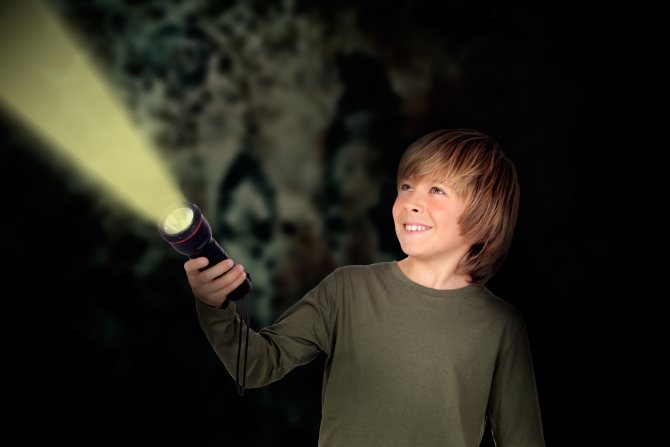
Child with a flashlight
My kindergarten
Author: Lyukshina Elena Anatolyevna. teacher of a speech therapy group of the highest category. MBDOU kindergarten No. 31 in Penza “Magic Country”.
DEVELOPMENT OF AUDITORY ATTENTION.
Game "Sun or Rain?"
Target . Teach children to perform actions according to the different sounds of the tambourine. Developing children's ability to switch auditory attention.
Short description:
The adult says to the children: “Now you and I will go for a walk. We go for a walk. There is no rain. The weather is good, the sun is shining, and you can pick flowers. You walk, and I will ring the tambourine, you will have fun walking to the sound of it. If it starts to rain, I will start knocking on the tambourine, and when you hear the knock, you must run into the house. Listen carefully when the tambourine rings and when I knock on it.”
Guidelines . The teacher plays the game, changing the sound of the tambourine 3 - 4 times.
DEVELOPING THE POWER OF THE VOICE.
Game "Come Play with Us"
Target . Teach children to speak loudly. Developing the ability to use a loud voice.
Preparatory work. Pick up toys: bear, bunny, fox.
Short description:
Children sit in a semicircle. An adult places toys at a distance of 2-3 m from the children and says: “It’s boring for the bear, the bunny and the fox to sit alone. Let's invite them to play with us. For them to hear us, we need to call loudly, like this: “Misha, go!” Children, together with the teacher, call the bear, fox, bunny, and then play with them.
Guidelines . Make sure that when children call for toys, they speak loudly and do not shout.
DEVELOPMENT OF AUDITORY ATTENTION.
Game "Guess who's screaming"
Target . Developing children's ability to focus auditory attention. Teach children to identify a toy by onomatopoeia.
Preparatory work . Prepare voiced toys depicting domestic animals familiar to children: cow, dog, goat, cat, etc.
Short description:
The adult takes out the prepared toys (one at a time), plays with them, imitating the cry of the corresponding animals, then asks the children to listen and guess by their voice who will come to visit them. The child chosen by the adult goes out the door and, opening it slightly, makes a voice, imitating one of the animals, and the children guess who it is.
Guidelines . The game can be repeated 5-6 times. Make sure children listen carefully. Encourage all children to ask questions
DEVELOPMENT OF CORRECT SOUND PRONUNCIATION.
The fairy tale “We hurried and made us laugh”
Target . To develop speech hearing and speech activity in children, to encourage them to pronounce sounds by imitation. Developing in children the ability to correctly pronounce sounds by imitation. Development of speech hearing. Preparatory work. Prepare a house for display on a flannelgraph, with a bear looking out the window; frog, mouse, chicken, goose, cow. Think through questions based on the text of the fairy tale.
Short description:
The frog jumped to the bear's house. She croaked under the window: “Kva-kva-kva - I’ve come to visit you!” A mouse came running. She squeaked: “Peep-pee-pee—your pies are delicious, they say!” The chicken has arrived. She cackled: “Ko-ko-ko—the crusts, they say, are crumbly!” The goose hobbled. Cackling: “Ho-ho-ho—I wish I could peck some peas!” The cow has arrived. Moos: “Moo-moo-moo - I wish I could drink some flour water!” Then a bear leaned out of the window. He growled: “R-r-r-r-r-r-r-r!” Everyone ran away. It was in vain that the cowards rushed. They should have listened to what the bear wanted to say. Here's what: “R-r-r-r-r-g-glad to have guests. Come in, please!"
Guidelines . The telling of a fairy tale should be accompanied by showing its characters on a flannelgraph. Onomatopoeia must be pronounced clearly, emphasizing the vowel sounds.
DEVELOPMENT OF SPEECH BREATHING.
Game "Butterfly, fly!"
Target . Achieve long, continuous oral exhalation.
Preparatory work . Prepare 5 brightly colored paper butterflies. Tie a thread 50 cm long to each and attach them to the cord at a distance of 35 cm from each other. Pull the cord between two posts so that the butterflies hang at the level of the standing child’s face.
Short description:
Children sit on chairs. The adult says: “Children, look how beautiful the butterflies are: blue, yellow, red! There are so many of them! They look like they're alive! Let's see if they can fly. (Blows on them.) Look, they flew. Try to blow too. Who will fly further? The adult invites the children to stand one by one next to each butterfly. Children blow on butterflies.
Guidelines . The game is repeated several times, each time with a new group of children. It is necessary to ensure that children stand straight and do not raise their shoulders when inhaling. You should only blow on one exhalation, without drawing in air. Do not puff out your cheeks, move your lips slightly forward. Each child can blow for no more than ten seconds with pauses, otherwise he may become dizzy.
DEVELOPMENT OF AUDITORY ATTENTION.
Game "Where did they call?"
Target . Teach children to determine the direction of sound. Development of the direction of auditory attention.
Preparatory work . An adult prepares a bell.
Short description:
Children sit in a circle. The adult chooses a driver who stands in the center of the circle. At the signal, the driver closes his eyes. Then the teacher gives one of the children a bell and invites them to call. The driver, without opening his eyes, must indicate with his hand the direction from which the sound is coming. If he points correctly, the adult says: “It’s time,” and the driver opens his eyes, and the one who called raises and shows the bell. If the driver makes a mistake, he guesses again, then another driver is appointed.
Guidelines . The game is repeated 4-5 times. You need to make sure that the driver does not open his eyes during the game. Indicating the direction of the sound, the driver turns to face the place from which the sound is heard. The call should not be very loud.
DEVELOPING THE POWER OF THE VOICE.
Game "Don't Wake Katya"
Target . Teach children to speak quietly. Developing the ability to use a quiet voice.
Preparatory work . An adult prepares a doll with closing eyes, a crib with bedding; small toys, such as a cube, a car, a turret, etc., as well as a toy box.
Short description:
The teacher puts a crib with a sleeping doll on his table and says: “Katya walked a lot, she’s tired. I had lunch and fell asleep. And we need to put away the toys, but only quietly, so as not to wake Katya. Come to me, Olya and Petya. Olya, quietly tell Petya which toy needs to be put in the box.” So the teacher calls all the children in twos, and they remove the toys placed on the table.
Guidelines . Make sure that children speak quietly, but not in a whisper.
DEVELOPMENT OF SPEECH BREATHING.
Game “Whose bird will fly farthest?”
Target . Achieve from each child the ability to make a long, continuous, directed exhalation. Education of long directed oral exhalation.
Preparatory work . The teacher cuts out birds from thin paper and colors them brightly.
Short description:
Birds are placed on two tables (at the very edge of the table) at a distance of at least 30 cm from each other. Four children are called, each sits opposite the bird. At the signal “the birds have flown,” the children blow on the figures, and the rest watch whose bird will fly farther.
Guidelines . Make sure that children do not puff out their cheeks when they blow on the paper birds. You can move the figure only with one exhalation. First, the teacher shows this, warning that it is impossible to blow on the bird several times in a row.
DEVELOPMENT OF AUDITORY ATTENTION.
Game "Guess what I'm playing on"
Target . Teach children to identify an object by ear by its sound. Cultivating stability of auditory attention.
Preparatory work . The teacher selects musical toys: drum, accordion, tambourine, organ, etc.
Short description:
An adult introduces children to musical toys: accordion, drum, organ, tambourine. Then he puts the toys behind the screen. Having played one of the instruments, he asks the children to guess what he played. The one who guessed correctly takes out the instrument from behind the screen and plays it.
Guidelines . Make sure that children sit quietly and listen carefully. There should be no more than four different instruments in one lesson. The game should be repeated 5-7 times.
DEVELOPING THE POWER OF THE VOICE.
Game "Loud - Quiet"
Target . Teach children to change the strength of their voice: speak loudly, then quietly. Developing the ability to change the strength of your voice.
Preparatory work . The teacher selects paired toys of different sizes: large and small cars, large and small drums, large and small pipes.
Short description:
An adult shows 2 cars and says: “When a big car drives, it beeps loudly: “beep.” How does a big car signal? Children say loudly: “Bee-Bee.” The teacher continues: “And the small car beeps quietly: “beep.” How does a small car honk? Children quietly say: “Bee-Bee.” The teacher removes both cars and says: “Now be careful. As soon as the car starts moving, you must give a horn, make no mistake, a big car honks loudly, and a small car honks quietly.”
The rest of the toys are played in the same way.
Guidelines . Depending on the number of children in the group, you can use one pair of toys or 2-3. Make sure that when pronouncing onomatopoeia quietly, children do not whisper.
DEVELOPMENT OF CORRECT SOUND PRONUNCIATION
A. Barto's poem “Who Screams?”
Target . Ensure that children correctly reproduce various onomatopoeias. Development of the ability to onomatopoeia, as well as speech hearing.
Preparatory work . Prepare toys: rooster, chicken, cat, dog, duck, cow. Think through questions for the text of the poem so that children actively use onomatopoeia in their answers.
Kook-ka-re-ku! I'm guarding the chickens. Kah-kah-kah! She's gone down in the bushes. Pur-murrr! I'm scaring the chickens. Am-am! Who's there? Quack-quack-quack! Rain tomorrow morning! Moo-moo- Milk for whom? Methodological instructions. You need to read the poem expressively, and while reading, show the children the appropriate toys.
DEVELOPMENT OF AUDITORY ATTENTION.
Game "Guess What They're Doing"
Target . Teach children to identify actions by sound. Cultivating stability of auditory attention.
Preparatory work . The teacher selects the following items: a glass of water, a bell, a wooden hammer.
Short description:
The teacher shows the children the prepared objects and performs various actions with them: hitting the table with a wooden hammer, ringing a bell, pouring water from glass to glass. Children watch and listen. Then the teacher removes everything behind the screen and repeats these actions there, and the children guess by the sound what he is doing.
Guidelines . If children find it difficult to determine the action, you need to clearly demonstrate it again. If they easily cope with the task, you can increase the number of objects or take objects that are similar in sound.
DEVELOPMENT OF SPEECH BREATHING.
Game "Sending the Boats"
Target . Achieve from each child the ability to pronounce the sound f for a long time on one exhalation or repeatedly pronounce the sound p (p-p-p) on one exhalation. Developing the ability to combine the pronunciation of a sound with the beginning of exhalation.
Preparatory work . An adult prepares a bowl of water and paper boats.
Short description:
The children sit in a large semicircle. There is a bowl of water on a small table in the center. The summoned children, sitting on chairs, blow on the boats, pronouncing the sound f or p.
The teacher invites the children to take a boat ride from one city to another, marking the cities with icons on the edges of the pelvis. In order for the boat to move, you need to blow on it slowly, with your lips pressed together, as if you were pronouncing the sound f. You can blow by simply stretching your lips with a tube, but without puffing out your cheeks. The ship moves smoothly. But then a gusty wind comes. “P-p-p...” the child blows. (When repeating the game, you need to drive the boat to a certain place.)
Guidelines . Make sure that when pronouncing the sound f, children do not puff out their cheeks; so that children pronounce the sound p on one exhalation 2-3 times and do not puff out their cheeks.
DEVELOPMENT OF VOICE PITCH.
The story “Who is screaming?”
Target . Teach children to speak in a “thin” voice and in a low voice. Developing the ability to raise and lower the tone of your voice.
Preparatory work . The teacher prepares pictures for work on a flannelgraph with images of a tree, a fence, a bird, a chick, a cat, a kitten, as well as a toy cat, a kitten, a bird, a chick.
Short description:
The teacher begins to talk, accompanying his speech by showing the corresponding figures on the flannelograph: “Early in the morning, we went out for a walk at the dacha. We hear someone squeaking thinly: “pee-pee” (pronounces onomatopoeia in a “thin” voice). We look, this chick is sitting on a tree and squeaking; waiting for his mother to bring him a worm. How thinly does the chick squeak? (“Pee-pi-pi.”) At this time, the bird flew in, gave the chick a worm and squealed: “pi-pi-pi” (pronounces onomatopoeia in a lower voice). How did the mother bird squeak? (“Peep-pee-pee.”)
The bird flew away and we moved on. We hear someone at the fence shouting thinly: “meow-meow-meow” (pronounces onomatopoeia in a “thin” voice). And the kitten jumped out onto the path. How did he meow? (Children reproduce the teacher’s example.) It was he who called the cat mother. She heard it, ran along the path and meowed:
“meow-meow-meow” (says “meow-meow” in a lower voice). How did the cat meow? (“Meow-meow-meow.”) And now, children, I’ll show you who came to visit us.” The teacher takes out the cat, shows how it walks along the table, then sits down. “How does a cat meow?” Children, lowering their voices, say: “meow-meow-meow.”
Then the teacher takes out a kitten, a bird, a chick, and the children imitate their voices.
Guidelines . Make sure that children do not shout, but speak calmly, raising and lowering their voice within the limits accessible to them.
DEVELOPMENT OF AUDITORY ATTENTION
Game "Guess what to do"
Target. Teach children to correlate the nature of their actions with the sound of the tambourine. Developing children's ability to switch auditory attention.
Preparatory work . Prepare 2 flags for each child.
Short description:
Children sit in a semicircle. Each person has 2 flags in their hands. If the teacher rings the tambourine loudly, the children raise the flags up and wave them; if quietly, they keep their hands on their knees.
Guidelines . An adult needs to monitor the correct posture of children and the correct execution of movements; It is necessary to alternate the loud and quiet sound of the tambourine no more than four times so that children can easily perform the movements.
DEVELOPMENT OF CORRECT SOUND PRONUNCIATION
Story "Song-song"
Target . Develop speech hearing and speech activity, encourage children to pronounce sounds and sound combinations by imitation. Clarification of sound pronunciation in children. Development of speech hearing.
Preparatory work . Pick up the following toys: a large doll, a rooster, a cat, a duck, a bear, a frog. Think through questions about the story so that the children’s answers include the onomatopoeia that is given in it.
The girl sang a song. She sang and sang and finished singing.
- Now you, cockerel, sing! - Ku-ka-re-ku! - the cockerel crowed.
“Sing, Murka!” “Meow, meow,” the cat sang.
“Your turn, duck!” “Quack, quack, quack,” the duck began to drawl.
- And you. Bear! - Roar-roar-r-ya-yav! - the bear growled.
- You, frog, sing! - Kwa-kwa-kwak-kk! - croaked the frog.
- And you, doll, what will you sing? - Ma-a-ma-a-ma! Mother! Folding song!
Guidelines . The teacher should accompany his story by showing character toys; Pronounce onomatopoeia clearly, and seek the same from children when answering questions about the story.
DEVELOPMENT OF SPEECH BREATHING.
Game "Poultry Farm"
Target. Development of speech breathing. Teach children on one exhale: pronounce 3-4 syllables.
Preparatory work . Choose sounding toys: chicken, rooster, duck, goose, chicken.
Short description:
The adult shows the toys to the children and plays their sounds 3-4 times in a row. The toys are put away. The teacher says: “Let’s go to the poultry farm. Let's go, and towards us... (shows a chicken) chicken. How will she greet us? Children: “ko-ko-ko.”
“We moved on. A goose is coming towards us. How will he greet us? Children: "ha-ha-ha." Next, the teacher sequentially shows the remaining toys, and the children pronounce the corresponding onomatopoeia.
Guidelines . First, all the participants in the game speak, then you can ask three or four children one at a time. Make sure that children pronounce onomatopoeias (ko-ko-ko, ha-ha-ga, pi-pi-pi, ku-ka-re-ku, quack-quack-quack) in one exhalation. Some children can pronounce 2-3 onomatopoeias, others - 3-4
DEVELOPMENT OF AUDITORY ATTENTION.
Game "Guess Who's Coming"
Target . Teach children to perform actions according to the tempo of the tambourine. Developing the ability to determine the tempo of a tambourine.
Preparatory work . The teacher prepares 2 pictures depicting a walking heron and a jumping sparrow.
Short description:
The teacher shows the children a picture of a heron and says that she has long legs, she walks importantly, slowly, as slowly as a tambourine will sound. The teacher slowly knocks on the tambourine, and the children walk like herons.
Then the adult shows a picture of a sparrow and says that the sparrow is jumping as fast as a tambourine will sound. He quickly knocks on the tambourine, and the children jump like sparrows. Then the teacher changes the tempo of the tambourine, and the children, accordingly, either walk like herons or jump like sparrows.
Guidelines . It is necessary to change the tempo of the tambourine no more than 4 - 5 times.
DEVELOPING THE POWER OF THE VOICE.
Game "The Wind Blows"
Target. Teach children to use a loud or quiet voice depending on the situation. Changing the strength of the voice.
Preparatory work . The teacher prepares 2 pictures. One depicts a light breeze shaking the grass and flowers. On the other there is a strong wind shaking the branches of the trees.
Short description:
Children sit in a semicircle on chairs. The teacher says: “We went for a walk in the forest in the summer. We are walking through a field, the sun is shining, a light breeze is blowing and the grass and flowers are swaying (shows a picture). He blows quietly, like this: “oo-oo-oo” (pronounces the sound u quietly and for a long time). We came to the forest and picked a lot of flowers and berries. We got ready to go back. Suddenly a strong wind blew (shows a picture). He hummed loudly: “oo-oo-oo...” (pronounces this sound loudly and for a long time). Children repeat after the teacher how a light breeze blows and how a strong wind hums.
Then the teacher shows the pictures without uttering the sound, and the children imitate the corresponding wind.
Guidelines . The teacher makes sure that the children, repeating after him, maintain the same strength of voice.
DEVELOPMENT OF SPEECH HEARING.
Game "Who is attentive?"
Target . Teach children to correctly perceive verbal instructions, regardless of the strength of the voice with which they are pronounced. Development of physical hearing acuity.
Preparatory work . Choose toys that are easy to perform various actions with.
Short description:
Children sit in 3 rows opposite the teacher's table. (First row at a distance of 2-3 m). There are various toys on the table. The adult says: “Children, now I will give tasks to those who are sitting in the front row. I will speak in a whisper, so I need to sit quietly so that everyone can hear. I will call everyone by name and give them a task, and you check whether it is being completed correctly. Be careful. Vova, take the bear and put it in the car.” All children sitting in the first row complete the tasks in turn. Then they change places: the second row takes the place of the first, the third - the second, the first - the third. Methodical instructions. The teacher needs to make sure that the children sit quietly and do not prompt each other. Assignments should be short and simple.
DEVELOPMENT OF SPEECH BREATHING.
The game “Whose steamer hums better?”
Target . Achieve the ability to direct the air stream in the middle of the tongue. Development of long-term targeted oral exhalation.
Preparatory work . The teacher prepares glass vials (according to the number of children) approximately 7 cm high, with a neck diameter of 1-1.5 cm, and puts stickers on them with the children’s names.
Short description:
Each child is given a clean bottle. The teacher says: “Children, listen to how my bubble buzzes if I blow into it. (It hums.) It hummed like a steamship. How will Misha’s steamer hum?” The teacher addresses each child in turn, and then invites everyone to hum together.
Guidelines . To buzz into a bottle, you need to slightly stick out the tip of your tongue so that it touches the edge of the neck. The bubble touches the chin. The stream of air should be long and go in the middle of the tongue. If the beep does not sound, it means that the child does not comply with one of these requirements. Each child can only blow for a few seconds to avoid dizziness.
DEVELOPING THE POWER OF YOUR VOICE
Game "Cat and Mice"
Target . Teach children to speak poetry quietly. Developing the ability to use a quiet voice.
Preparatory work . Prepare hats with a picture of a cat. Learn the text of the poem with the children.
Short description:
Children walk in a circle, in the center of which a child squatting, pretending to be a cat. Children say in a quiet voice:
“Hush, mice.
Hush, mice.
The cat is sitting on our roof.
Mouse, mouse, watch out!
And don’t get caught by the cat!”
A child pretending to be a cat meows loudly and runs after the children. Those caught become cats.
Guidelines . Make sure that children do not increase their voice, but do not speak in a whisper.
DEVELOPING THE POWER OF YOUR VOICE
Exercise "Beep"
Target. Teach children to change the strength of their voice from loud to quiet. Developing the ability to regulate voice strength.
Preparatory work . Prepare a picture of a steam locomotive.
Short description:
Children stand in one row facing the teacher and raise their arms up from their sides until their palms meet. Then slowly lower it down through the sides. Simultaneously with lowering their hands, children pronounce the sound u, first loudly, and then gradually quieter (the locomotive moves away). They lower their hands and fall silent.
Guidelines . First, the teacher himself demonstrates the exercise, then he calls two children who pretend to be a beep with him. The rest of the children only make movements with their hands. Then the whole group takes part in the game.
DEVELOPMENT OF SPEECH BREATHING.
Game “Match by color”
Target . Teach children to pronounce a phrase of two or three words together. Development of smooth speech exhalation.
Preparatory work . Select object pictures of primary colors and make cubes of the same colors from cardboard without one edge.
Short description:
Children are given pictures with objects of different colors on them. Showing the cube, the teacher says: “Whoever has pictures of the same color as the cube, come here.” Children go out, show their pictures, name them (“Red Car”, “Red Ball”, etc.) and put them in this cube. The game continues until all the children have put their pictures into cubes.
Guidelines . Make sure that the children say the words together, in one breath.
DEVELOPMENT OF SPEECH HEARING.
Game "Guess whether the train is near or far"
Target . Teach children to correctly determine the strength of their voice. Development of the ability to distinguish the intensity of sound by ear.
Preparatory work . Pick up 3 pictures that show a train. In the first picture the train is standing at the station. On the second, she moves away from her, the mourners waving after her. The third shows a station; in the distance, behind the forest, the last train car is visible.
Short description:
The teacher puts 3 pictures of a train on the board. He says: “The train is buzzing before leaving the station - ooh . The train is close and we hear a loud whistle. (Pronounces the sound u in a loud voice.) When the train left the station and began to whistle, we heard a not so loud whistle. (Pronounces onomatopoeia in an ordinary voice of medium volume.) And when the train went far away and began to whistle, it was barely audible.” (Says onomatopoeia in a quiet voice.)
Next, the teacher pronounces the sound y with different voice strengths, and the children indicate the corresponding picture.
Guidelines . If the children answer correctly, then they themselves can take turns leading (signal with a voice of varying strength)
DEVELOPMENT OF SPEECH BREATHING
Game "When does this happen?"
Target . Achieve the ability to pronounce a four-word phrase in one breath. Development of smooth speech exhalation.
Preparatory work . Select story pictures (according to the number of children) depicting various signs of the seasons. (Handouts can be taken from the “Seasons” lotto or selected from various books and magazines.)
Short description:
The teacher hangs pictures depicting the four seasons on the board. At the bottom of each picture there is a paper pocket in which you can put small pictures reflecting various signs of a particular time of year (“Children make a snow woman”, “Boys hang birdhouses”, “Girls collect bouquets of flowers”, “Yellow leaves are falling from trees” " etc.).
The teacher calls the children one by one and gives them one picture each. The child comes to the table, shows everyone his picture and answers the question posed by the teacher, for example: “When do children swim in the river?” (“Children bathe in the river in summer.”) Having given a complete answer, he puts the picture in the pocket of a large painting that depicts the corresponding season.
Guidelines . Before the game starts, the teacher explains to the children that they should not speak abruptly, making stops after each word. If the child cannot give a complete answer to the teacher’s question or his speech is abrupt, the teacher offers a sample of correct speech and then repeats the answer with the child.
DEVELOPMENT OF VOICE PITCH.
Target . To develop in children the ability to change the pitch of their voice. Changing the pitch of the voice.
Short description:
An adult tells the fairy tale “The Three Bears”, accompanying his speech with illustrations. Then he asks the children questions, for example: “What did Mikhail Ivanovich say when he saw that his chair had been moved?” Children, when answering questions, change the pitch of their voices accordingly.
Guidelines . The adult makes sure that, imitating Mishutka, Anastasia Petrovna and Mikhail Ivanovich, the children do not speak very high (to the point of squeaking) and very low (to the point of hoarseness in their voice), that is, that they raise and lower their voices within the limits accessible to them.
SPEECH HEARING DEVELOPMENT
Game "Guess Who Said"»
Target . Teach children to distinguish between low, medium and high voices by ear. Development of the ability to distinguish the pitch of the voice.
Preparatory work . Select pictures depicting characters from the fairy tale “The Three Bears” (Mikhail Ivanovich, Anastasia Petrovna and Mishutka). For each character - 8-9 pictures.
Short description:
Each child receives a picture of one of the bears. The teacher pronounces phrases from the text of the fairy tale, changing the pitch of his voice, and the children pick up the corresponding pictures.
Guidelines . In order to activate the attention of children, the teacher breaks the sequence of statements of the characters adopted in the fairy tale.
DEVELOPING THE POWER OF YOUR VOICE
Game "Echo"
Target . Developing the ability to use a quiet and loud voice. Teach children to speak loudly and quietly.
Preparatory work . The teacher selects the picture “The children got lost in the forest.”
Short description:
Children are divided into 2 groups. One depicts children who are lost in the forest, the other is an echo. Each group is located in different corners of the room. Children who are lost in the forest loudly call the children of another subgroup by name; “Ay, Olya! Hey, Petya! Children pretending to be an “echo” repeat the same words quietly. Then the participants in the game change roles.
Guidelines . Make sure that the children pause after calling the name, giving the “echo” the opportunity to repeat their words.
DEVELOPMENT OF SPEECH BREATHING
Game “Locate the toy”
Target . Achieve the ability to pronounce a phrase of five to six words together, on one exhalation. Development of prolonged speech exhalation.
Preparatory work . The adult selects various toys that are well known to the children.
Short description:
The teacher lays out various children's toys (car, pyramid, ball, bear, doll, etc.) on the table in one row. Calling the child, he asks: “Between which toys is the pyramid standing?” The child must give a complete answer: “The pyramid stands between the car and the ball.” After two or three answers, the adult changes places of the toys. Gradually, as you repeat the game, you can replace the toys with others one by one. Methodical instructions. When conducting the game, the teacher makes sure that the children speak slowly, without separating one word from another with long pauses. You must answer the question with a complete answer, for example: “The ball lies between the doll and the bear.”
SPEECH HEARING DEVELOPMENT
Game "Guess what to do"
Target . Teach children to determine the tempo of speech by ear and perform movements at the appropriate pace. Development of the ability to detect by ear changes in the tempo of speech.
Preparatory work . Choose phrases that indicate actions that can be performed at different paces.
Short description:
The teacher pronounces the phrase: “The mill grinds grain” several times at different tempos. Children, imitating the operation of a mill, make circular movements with their hands at the same pace at which the teacher speaks. The following phrases are also played out: “Our feet walked along the road”, “The children swam in the river”, etc.
Guidelines . An adult should pronounce the phrase smoothly, continuously, repeating it 2-3 times in a row at any pace, so that it is easier for children to perform the movements.
DEVELOPING THE POWER OF THE VOICE.
Game "Blizzard".
Goal To teach children to change the strength of their voice from quiet to loud and from loud to quiet in one exhalation. Changing the strength of the voice.
Preparatory work . Choose a picture that shows a blizzard.
Short description:
The teacher shows a picture of a blizzard. Children sitting in a row depict a blizzard howling on a winter evening. At the teacher’s signal “the blizzard is starting,” the children quietly say: “uuu ...”; at the signal “strong blizzard” they say loudly: “ uuu ...”; at the signal “the blizzard ends” they speak more quietly; at the signal “the blizzard is over” they fall silent.
Guidelines . quietly on one exhalation , then loudly and quietly again, so the adult quickly replaces one signal with another.
DEVELOPMENT OF SPEECH BREATHING
The game “Who can inflate the toy better?”
Target . Teach children to inhale through their nose and exhale through their mouth. Development of differentiated breathing.
Preparatory work . An adult prepares small inflatable children's toys for each child, such that they can be inflated in 3-4 exhalations.
Short description:
The teacher shows the children how to inflate the toy: he takes in air through his nose and slowly exhales it through his mouth into the hole of the toy. Anyone who completes the task correctly can play with an inflatable toy. Methodical instructions. The game is best played with subgroups of children of five to six people.
SPEECH HEARING DEVELOPMENT
Game “To whom did the wolf come, from whom did it leave?”
Target . Teach children to identify a character by changing the tone of their voice. Developing the ability to detect by ear a change in voice tone.
Preparatory work . Pick up plot pictures: the wolf came to the hut to the kids; the wolf came to his cubs; the wolf came to the hunter; the wolf leaves the piglets' hut; the wolf leaves the wolf cubs; the wolf runs away from the hunter.
Short description:
The teacher puts 3 pictures on the board, which depict a wolf coming to the kids, to the wolf cubs, to the hunter. He pronounces the phrase The wolf came with different intonations: with fear, with joy, with surprise. Children must determine who said this - goats, wolves or a hunter. Similar work is carried out on three other pictures (the phrase The wolf left is said with joy, with regret, with annoyance).
Guidelines . Children must listen carefully to the teacher; they must be activated with questions like “Why did you guess that the kids said that?”
DEVELOPMENT OF SPEECH BREATHING
Exercise "Divers"
Target . Teach children to inhale through their mouth and exhale through their nose. Development of differentiated breathing.
Preparatory work . The teacher selects pictures that depict children diving and jumping from a tower.
Short description:
Children, spreading their arms to the sides, inhale through their mouths. Wrapping your arms around yourself and squatting (“sinking under the water”), exhale through your nose.
Guidelines . Each child repeats the exercise no more than two or three times.
Didactic games for the development of speech of preschoolers card index on speech therapy on the topic
Reminder for parents
“We talk, we play – we develop our discourse”
DEAR PARENTS!
Talk to the kids!
There is a lot of talk about how good language development is a prerequisite for academic success. However, parents do not always know how to develop this speech.
You can often hear: “We read a lot to the child, read poems, talked about everything, but there was no result; The child himself cannot describe the simplest image or tell anything.”
How could it be otherwise: after all, it was the parents who said it, not the child. Babies are all different - some are unstoppable, while others say nothing. But even the “silent” will speak if there is an incentive to speak out.
The performance begins with the desire to communicate!
No matter how imperfectly your child speaks, accept his desire and indulge him. Even if he doesn't speak at all, often engage him in nonverbal dialogue, welcoming and approving any response (gesture, expressive look). At the same time, try to give him the opportunity to listen to himself and himself. Especially create play situations where the child will need onomatopoeia or will have to say a few words for the game to take place. Keep in mind that it is not you who motivates, but the situation. Mood.
Try to pronounce a new word in an emotionally favorable situation: when the child is calm, in a good mood, in such conditions the child assimilates and assimilates information 10 times better than neutral or unfavorable information.
How can you develop speech?
1. Whether you are looking at an image, reading a book, draw your child’s attention to rare phrases, ask what this or that word means.
2. Play the game “Tell Me the Word”: an adult reads a short poem, and the child must guess and name the last word in it.
3. Play with words. This can make a long journey in transport, or the need to lie in bed, cheer up. These tasks include:
- what words, colors can describe the time of year, tell about the topic, what it is about (quote as many adjectives as possible);
- what he can do (name as many verbs as possible)
- play a bad and a good game. What is good about Baba Yaga and what is bad? What is good in the rain and what is bad?
- play opposite words (opposites)
4. Invite your child to tell a story, story, or cartoon. Ask what you liked and why. Ask to describe your favorite character.
5. Play the game: “Find the error in the sentence”
6. Teach your child to make a story from an image. Explain that a story has a beginning (as short as the morning), a center (as the day), and an end (as short as the evening).
7. Play a familiar fairy tale face-to-face with different intonations.
Remember! It's very easy to knock over a child. Treat your child with understanding.
Expand your child's vocabulary.
A child has words on two levels: he understands words - this is passive vocabulary, he speaks - he is active. The active vocabulary can be quite small. Try entering the names of things around it (toys, household items), the names of family and friends into the active dictionary. More often they ask: “Where is the table? Where's the clock? ”etc. This will certainly lead to an increase in vocabulary. Develop phonemic awareness (the ability to hear different speech sounds) by encouraging different sound words. (roof – mouse, nose – knife).
Read to your child.
Read short poems and fairy tales. Read them many times: don’t be afraid that your child will get tired of it. Children learn much better from texts they have already heard. If possible, try to quote the poem - show it with faces and objects; and let your child play with objects. Wait until the child has a good memory of the poem, get a feel for the rhythm, then try not to finish the last word of each line, allowing the child to do so. Sing simple songs to help him feel the rhythm and play it.
What else to read: Didactic game “What grows in the garden?”
Fingers help the word.
Pay attention to the development of fine motor skills - precise finger movements. Modeling, drawing, finger theater, playing with small objects - all this will help speech, and in the future, writing. The child should work with naughty fingers as much as possible. No matter how boring it may seem, let the child button up his buttons, tie his shoelaces, and roll up his sleeves. It is also better to start training not with your own clothes, but first “help” the doll and even the parents get dressed. As a child's fingers become more dexterous, his speech will become more understandable to others. About the benefits of joint gymnastics in the development of a preschooler.
Joint gymnastics in the development of preschoolers.
Gymnastics for arms and legs is familiar to us. We train the muscles so that they become flexible, strong and agile. But why train? It turns out that the tongue is the main muscle of the speech organs. And like any muscle, it simply needs gymnastics. After all, the tongue must be well developed to make the subtle, intentional movements that produce speech sounds.
Pronunciation deficiencies aggravate the emotional and mental state of the child, preventing him from developing and communicating with peers. To prevent this problem from arising, you should start doing gymnastics for your joints now. With the help of articulatory gymnastics, existing violations of sound pronunciation are overcome.
At first, gymnastics should be done in front of a mirror. The child must see what his tongue is doing and where it is. In this case, the movements of the tongue are brought to automaticity by constant exercises. Work with your child every day for 5-7 minutes. Carrying out articulatory gymnastics in the form of a fairy tale (in a funny language) will help turn the exercises into an exciting game.
Believe in yourself!
Remember: only you and your faith in the child’s strengths and abilities can help him develop harmoniously. Be patient, kind and calm and you will succeed.
Development of fine motor skills to prepare the hand for writing.
It has now been shown that the development of fine motor skills of the fingers has a positive effect on the speech development of children. Employees of the Institute of Physiology and Adolescence of the Academy of Pedagogical Sciences of the Russian Federation determined that the projection of the hand to the brain is very close to the area of the speech motor. The relationship between the motor and speech zones is also manifested in the fact that a person who has difficulty finding a word helps himself with gestures, and vice versa: a child focused on drawing or writing involuntarily sticks out his tongue.
Therefore, training the movements of fingers and hands is the most important factor that stimulates the development of a child’s speech, helps improve articulatory movements, prepares the hand for writing, as well as a powerful tool that increases the performance of the cerebral cortex and, as a result, the level of development of thinking.
Activities that develop fine motor skills.
Have a beneficial effect on the development of hand and finger movements:
- massages and self-massage;
- finger gymnastics;
- visual activity;
- modeling;
- drawing;
- statement;
- handmade;
- manipulations with various objects: collecting pyramids, nesting dolls, builders, mosaics; unfastening and fastening buttons, Velcro, straps; lacing.
- shading, writing.
Games and exercises for children 2-4 years old.
Magic bag.
Examine toys and objects with your baby and touch them. Invite your child to touch one of the items in the bag, name it, and pick it up. Without removing the object, touch it, name it and describe it.
Tactile tables.
it is necessary to prepare a series of boards with different structural surfaces; with images of various objects cut out along the contour.
Tasks: with eyes closed, feel the outline and name the depicted object; find a specific image of an object with your eyes closed; find two identical cards.
Finger pool.
Tasks: lower your hands to the pool of fingers and touch the beans or peas; move to another container one by one; clench and unclench fists with beans and peas while holding hands in the pool; touch this object.
I turn and turn.
(Tasks with various massage balls, sticks, chestnuts, nuts, etc.)
Throw and grab an object with one hand, two hands, unfold an acorn or pine cone. Roll a massage ball or stick: with your palm, the edge of your palm, the finger of one palm towards the other, between your palms, on the back of your hand with rotational movements in one direction, in the other direction, vertically. Gradually increase pressure and rotation speed.
Rope.
Tasks: tie and untie knots; twine: remove the beads, twist the lace between the tips of the thumb and forefinger, wind the lace on a stick or thread on a spool, braid a pigtail, intertwine fingers with lace, decorate patterns and figures with lace.
Clothespins.
Tasks: use clothespins to hook a sheet of paper, the edge of a box or cup, or a rope; open and close the clothespin with your thumb and index finger, thumb and middle finger, etc. Ask your child to count the number of clothespins on the string, and only put clothespins of a certain color on the string.
What else to read: Developing figurative memory. Geometric figures
Exercises with vocal accompaniment.
Fox.
Rhythmic opening and closing of a clothespin while pronouncing the text:
“Clever scammer, redhead. The mouth opens, it scares the rabbits.”
Crow.
Bend your hand towards the table and take the candy wrapper. Then the brush returns to its original position. Talk:
“I saw the paper and how to take it. I thought it was candy, but it turned out to be a candy wrapper.”
Dogs.
The exercises involve both hands, which rhythmically open and close clothespins while pronouncing the text:
“Two dogs bark, don’t bite. Two cubs walk around in the nest all day, screaming, opening their mouths to the crows, and really want to eat.”
For children 5-7 years old.
Finger gymnastics, games with letters and words. As a physical exercise, it is very good to use finger exercises with speech accompaniment. The dictionary has dozens of poems on every topic. For example:
The sky in Russia is blue
The rivers in Russia are blue – they bend like your finger.
There are maples and oaks, the fingers represent “branches”
What kind of mushrooms are there? The fist of one palm is covered with the other open palm.
Children love to speak in a secret language. Create your alphabet with your fingers. Use it to guess letters and then form words. [2]
Arrange the figures, counting sticks and matches.
Finger Theater. They develop attention, thinking, memory, stimulate the baby’s speech development, help relieve tension from the hands and lips, relieve mental fatigue, develop arms, become more mobile and flexible. Advise parents to take their children to a real theater to see various children's performances.
Written works, various types of shading, coloring of figures, pictures.
Currently, there is a large selection of literature on this topic. You can purchase it to your liking, but make sure the instructions are appropriate for your child's age and difficulty level.
Card file of speech therapy games for children with special needs development
Olesya Levchenko
Card file of speech therapy games for children with special needs development
CARD FILE OF Speech Therapy GAMES FOR CHILDREN WITH ODD
Content component.
In recent years, the number of children with speech disorders has increased significantly. And every year the number of practically non-speaking children increases. The reasons for this phenomenon are varied and numerous.
Unfortunately, children with speech disorders often get to see a speech therapist only before school, at best, after five years, and the most significant age for the development of a child’s speech, the age of three, turns out to be missed.
Speech therapy work is based on the principle of repeated repetition of material, and what could be more boring for a preschooler whose leading activity is play? And in order to arouse the child’s interest in classes, the speech therapist must introduce the maximum number of didactic games.
Play is one of the most important methods of working with preschool children. The game method of teaching helps to create an interested, relaxed atmosphere and establish a psychologically age-appropriate communication situation. In play activities, the child’s individuality is revealed, feelings of collectivism and mutual understanding are formed, and children’s creative abilities are developed.
A good, smart and entertaining game activates children's attention, relieves psychological and physical stress, and ensures the perception of new material.
How are games used in speech therapy work?
Thus, we can formulate two main tasks facing a speech therapist in his work with preschoolers.
1. A speech therapist needs to widely use games in correctional work, while remembering their importance in general as a means of physical, mental, moral and aesthetic education of children.
2. When conducting the game, the speech therapist must take into account the possible behavioral characteristics of children with various speech disorders.
The main training from speech therapists comes through exercises on pronunciation and speech development. But you need to remember one important rule! It’s better for your child to leave your lesson without finishing the game than after overplaying it. Thus, a deficit of play is created and the child will definitely want to return to class and will do it with pleasure.
The need for speech therapists to carry out correctional work with preschoolers through play is obvious. The work of a speech therapist requires the use of gaming techniques to an even greater extent than in conventional educational activities. The presence of a speech defect leads to changes in the mental sphere, namely the appearance of such traits as increased irritability, excitability, isolation, etc.
In modern methodological literature on speech therapy, various games are recommended when working with preschool children. The authors of methodological literature strongly recommend the use of games to correct speech disorders in children. In many cases, examples of such games are given, which are modified versions of games well known in preschool pedagogy, but they are often invented by the authors themselves.
As a rule, the bulk of games and game aids are aimed at automating sounds and developing coherent speech in preschoolers. But since I work with children with special needs, I also need to cover vocabulary and grammatical structure of speech. Therefore, the basis of this methodological development was the systematization of games and gaming aids necessary for teaching senior preschoolers with ODD. Here we will present the author's developments of games tested in practice, as well as games already presented in modern methodological literature.
Increasingly, in the senior and school-preparatory groups of kindergarten, children are diagnosed with GSD (general speech underdevelopment). This is a systemic disorder in which sound pronunciation, phonemic perception, syllable structure and sound pronunciation of words are impaired, and speech is saturated with agrammatisms. Children have a poor vocabulary. Coherent speech suffers. There are also deviations in the development of motor skills, both general and articulatory.
As a result, children encounter difficulties in the learning process and poorly assimilate program material. In this regard, there is a need to use effective methods of teaching and correctional work that ensure that children successfully master the knowledge, skills and abilities provided for by the program, and play comes to the rescue and the direction of correctional work becomes important. The advantage of the game is that it allows you to more actively influence the child. With the help of games, a strong interest in classes, a desire to learn new things and assimilate knowledge and skills are maintained.
Games aimed at developing fine motor skills.
1. PALM. The contours of the palms are drawn on a sheet of paper. Each page contains a different position of the palms (fingers together, apart, bent, etc.) The child, placing his palms, must repeat the image as accurately as possible.
2 ROLLING THE BALLS. Children roll small balls around the table (along the playing field on which you can draw different paths - straight, curved, spiral). During the game, the ball should not slip out from under the palm and should roll exactly along the path. Balls can be rolled either with your palms (in the first games) or with one finger (in subsequent games).
3. SORTING SMALL ITEMS. It is very important that the baby does this either with a pinch (with three fingers), or using the “tweezer grip” method (grabbed with two fingers - the thumb and forefinger). At the same time, the other fingers should be tucked in and not interfere. Show the baby the correct way to do this exercise. You can sort by color (if you mixed beads of two colors, by shape, by size. Sorting small items is very important in the third year of a child’s life.
4. KNEADING PLASTICINE. This is a very useful exercise for developing fine motor skills.
5. STRINGING RINGS ON THE PYRAMID ROD. First, the baby learns to disassemble the pyramid toy (this is easier), and only then assemble it. Please note - even the smallest children easily remember the sequence of colors in the pyramid and assemble it simply from memory, and not from comparing values. Therefore, if you want to teach them to compare size of the rings and arrange them from largest to smallest sequentially, then you need a pyramid with rings of the same color!
Development of articulatory motor skills
To present the exercise to preschoolers in a non-boring way, we select pictures and poems for each exercise. Games aimed at developing and activating vocabulary.
1. ADD A WORD
Several people play. The first one names an object. The second repeats this word and adds one of his own, the third repeats the first two in order and names his own, etc. until someone gets confused. The game promotes the development of voluntary attention and memory.
2. VERBAL DOMINO
Several people play. Everyone takes turns pronouncing any phrases, but with a certain condition: each next player begins his phrase with the last word of the previous player’s sentence.
3. SIGNS OF WORDS
The child is told:
1st option. “Now I will name the words, and you must tell me what this object can do. For example, a blizzard is blowing, and thunder is ?; wind -. , and snow -. ; rain - and sun -. With each answer, the child is asked: “What else does the sun do, because it not only shines?” The child must select as many words as possible that denote the action. The same game can be played in reverse: “Who flies? Who swims? Who hammers the nails? Who catches mice?
2nd option. “Name another object that is as white as snow” (as narrow as a ribbon; as fast as a river; as round as a ball; as yellow as a melon, etc.).
3rd option. “Compare by taste - lemon and honey, onion and apple, by color - cloves and chamomile, pear and plum, by strength - rope and thread, stone and clay, by width - road and path, river and stream, by height - bush and tree, mountain and hill."
4. WORDS ARE FRIENDS
The child is asked to choose synonyms for the given words:
1st option. How can you say differently about a sad person? (Sad, upset.)
2nd option. What word can replace the word “horse”? (Doctor, horse, cup, food, etc.)
5. FOUR ONE
The child is asked to determine which word is superfluous, not suitable for other words, and explain why:
Sad, sorrowful, dejected, deep;
Brave, loud, courageous, daring;
Weak, brittle, long, fragile;
Strong, distant, durable, reliable.
If a child does not understand the meaning of a word, it should be explained to him.
3rd option. “Compare by taste - lemon and honey, onion and apple, by color - cloves and chamomile, pear and plum, by strength - rope and thread, stone and clay, by width - road and path, river and stream, by height - bush and tree, mountain and hill."
4. WORDS ARE FRIENDS
The child is asked to choose synonyms for the given words:
1st option. How can you say differently about a sad person? (Sad, upset.)
2nd option. What word can replace the word “horse”? (Doctor, horse, cup, food, etc.)
5. FOUR ONE
The child is asked to determine which word is superfluous, not suitable for other words, and explain why:
Sad, sorrowful, dejected, deep;
Brave, loud, courageous, daring;
Weak, brittle, long, fragile;
Strong, distant, durable, reliable.
If a child does not understand the meaning of a word, it should be explained to him.
Didactic games for the formation of grammatical structure of speech can be divided into three main groups:
Games and exercises for inflection:
- they learn to use case forms correctly, the most difficult of which for them is the genitive plural, games: “What’s missing?”, “What’s missing from the doll?”, “Paired pictures”, etc.
- use indeclinable nouns such as coat, coffee, radio, kangaroo, games “Atelier”, “Cafe”, etc.)
- correctly coordinate adjectives with nouns in gender, number, case and coordinate with verbs and prepositions. (“Which, Which, Which?”, “Who is doing what?”, “Guess what it is?”, “Tell about the subject”).
- distinguish verbs by aspect, person, number, tense, gender and mood. A special place is occupied by games for the correct use of so-called “difficult” verbs: want, call, run, etc. (games “Do you want? - We want”, “Hello, hello.”, etc.).
Games and exercises for word formation:
Didactic games for word formation can be divided into 4 subgroups:
Formation of baby animal names
Formation of profession names
Formation of names of dishes
Formation of cognates
In the field of word formation, preschoolers are taught to create new (same-root) words using:
· suffixes: hare - bunny, bunny;
· prefixes: sew - sew, sew up, embroider;
· mixed method: tabletop, running, running, etc.
The learning process includes games that help you understand the change in the meaning of a word depending on word-formation shades: mustache - mustache - mustache; cat - cat - cat. The teacher teaches the children to form adjectives from the stems of nouns: What kind of raspberry jam? From strawberries? From currants?; and the formation of possessive adjectives (the meaning of belonging).
Games and exercises to improve the syntactic side of speech.
Mastery of the syntactic structure of speech occurs in the process of verbal communication, where the main methodological technique is the teacher’s questions: “Why?”, “Why?”, “What would happen if...”.
An important means of developing preschoolers’ skills in constructing sentences of different types are special games and exercises: “Complete the sentence”, “Complete the sentence”, “Who should we take for a ride?”, “Blurred letter”, etc.
Games aimed at developing coherent speech
Word game “Let’s weave a wreath of sentences.” The teacher pronounces a sentence, and the children find the last word in it and come up with a sentence with it, etc. For example: 1. Seryozha is reading a book. 2. The book is on the table. 3. My desk is clean. 4. Clean hands are the key to health, etc.
Game "Riddle and Guess". The driver (adult or child, using cards - “definitions and signs” of the word. Players try to find the hidden object. The one who guessed right becomes the driver.
Game "Make a story." The teacher gives each child a diagram card with conventional images: the sun, a tree, a feeder, birds and offers to compose a story on the topic “Migratory Birds” according to the diagram. Thus, stories are compiled on different lexical topics.
Game "Shop". Using models, the child describes vegetables, fruits, furniture, clothes, etc.
A didactic game is one of the forms of teaching influence of teachers on a child, at the same time, the game is the main activity of children. Thus, the game realizes educational (which the teacher pursues) and gaming (for which the child acts) goals. It is important that these two goals complement each other and ensure the assimilation of program material. A didactic game is a valuable means of cultivating mental activity; it activates mental processes and arouses a keen interest in the process of cognition in preschoolers. The game helps to make any educational material exciting, causes deep satisfaction in children, stimulates performance, and facilitates the process of assimilation of knowledge.
How to conduct classes at home
For many children, homework is much more fun than with a specialist. The child sees his mother or any other person he knows and feels safe. To get the most out of your lessons, you can purchase special guides that not only explain in detail how to set up and automate each sound, but also record the results. An example is N.V.’s speech therapy notebook. Sokolova.
Methods for correcting general speech underdevelopment in preschool children
For your information! Initially, speech therapy games should be accompanied by a voice explanation from an adult. After this, only the child should speak (or try to speak.
Speech therapy games for setting the sounds Ш and Ж
These sounds require a flattened position of the tongue, with the tip pressed against the upper palate. This can be achieved using the following exercises:
- "Shoulder". Stick out your wide tongue and place it on your lower lip.
- "Brush". Run the tip of your tongue from your teeth to your throat and vice versa.
- "Delicious jam." He licks his upper lip as if licking sweetness.
Speech therapy games for setting the sounds L and R
Both sounds require tension of the tip of the tongue against the roof of the mouth. However, the exercises for setting up sounds will be different.
Setting the “L” sound:
- "Punish your tongue." Extend and spread your tongue over your lower lip and lightly bite it with your upper teeth, making a “roo” sound.
- Alternating “spatula” and “back”. The tongue is spread over the lower lip or tense and is in the middle of the half-open mouth.
- "Horse". The purpose of this exercise is to teach the child to click by pressing the tongue against the alveoli behind the upper teeth.
Setting the "R" sound:
- "Car". Open your mouth wide, press your tongue against the upper tubercles and quickly say “ttt”, simulating automatic fire.
- "Brush your teeth". Run your tongue behind your upper teeth to the right and left.
- "Swing for children." Open your mouth and place the tip of your tongue directly on your upper lip, then on your lower lip.
Speech therapy games for setting the sounds Z, S and C
Normally, a child pronounces whistles correctly at 4 years of age. Exercises to help reproduce these sounds:
- Alternating a smile with the “Tube” exercise. Smile widely, hold this position for a few seconds, then purse your lips.
- "Pendulum". Open your mouth and point the tight tip of your tongue from the right to the left corner.
- "Slide". Place the tip of your tongue on your lower teeth and lift the middle palate above the upper palate, forming a cusp.
Important! When explaining the exercise, be sure to have a tabletop mirror with you, in which the child will see his reflection.
Each exercise must be repeated six times, the total execution time should not exceed 2-3 minutes. When trying to correct the situation, do not put a dirty hand in your baby’s mouth. If it is not possible to purchase special tools for a speech therapist (spatula), in case of forced contact with the child’s oral cavity, you can use a teaspoon, first sterilized in hot water.
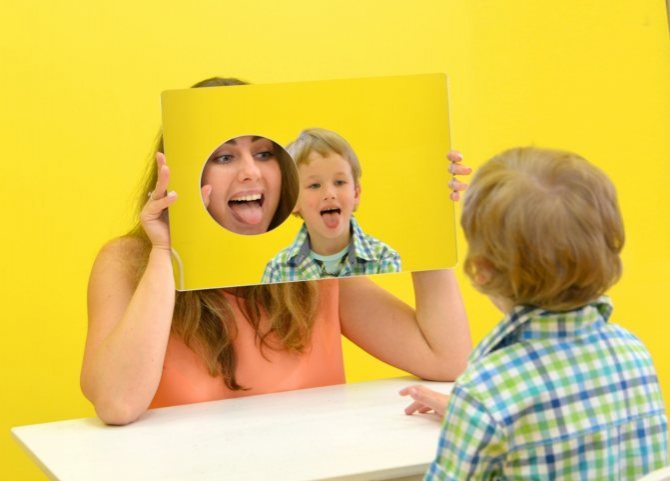
Mirror in speech therapy games



